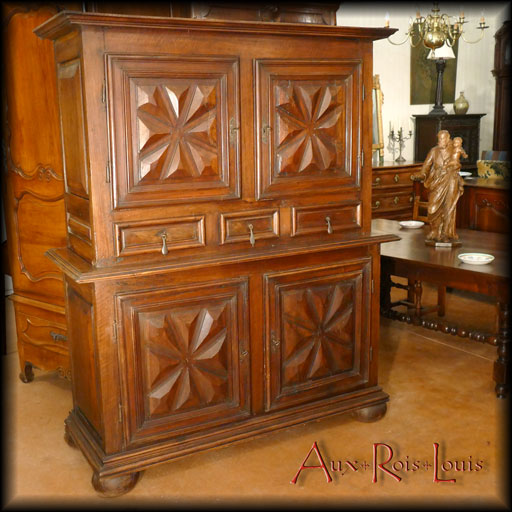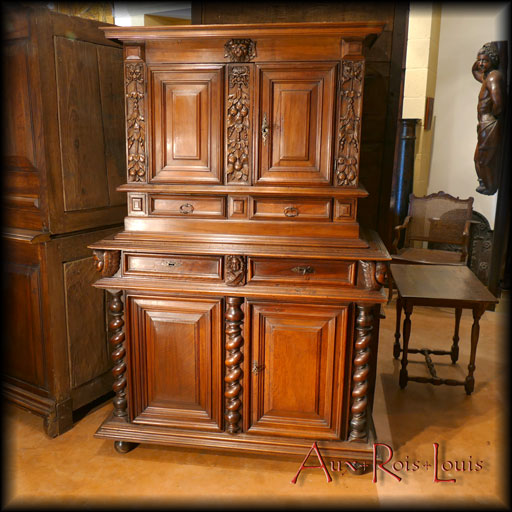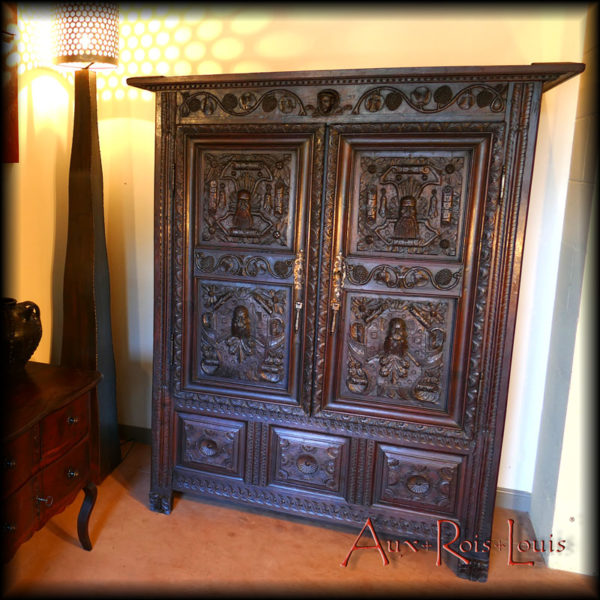Bronze Chandelier – Louis XIV – 17th Century – Quercy – [ME117]
In golden bronze, this midsize chandelier can hold candles at the top of the four candle holders that top its branches. As was practiced in the 17th century, four small vessels are arranged in the center to receive walnut oil and wicks to complement the original lighting setup. Below, a bowl is ready to absorb any potential overflow.

![Bronze chandelier – Louis XIV – 17th century – Quercy – [ME117] What characterizes this bronze chandelier from the 17th century is that it has never been converted to electricity. Everything here is original, and only the candles are adapted to its candle holders. Additionally, small vessels are intended to receive walnut oil and wicks to complete the decidedly intimate lighting setup.](https://www.aux-rois-louis.com/wp-content/uploads/2023/11/ME117_P1670115-600x600.webp)
![Peasant Crowned Jug – 17th Century – Auvergne – [PA086] Here is a charming oil jug crafted in the workshop of peasant potters in Brioude, Auvergne, France, in the 17th century. It is adorned with a crown-shaped motif around the summit opening, a detail envisioned by the peasant who shaped it with precision and, clearly, with love too.](https://www.aux-rois-louis.com/wp-content/uploads/2024/01/PA086_P1680261-600x600.webp)
![Oak and Embossed Leather Armchair – Louis XIII – 17th Century – Aquitaine – [ME128] The sturdy structure of this Louis XIII armchair is softened by bead turnings that adorn the armrests, armrest supports, and base. The backrest and seat are upholstered in embossed leather known as "Cordovan," revealing lush patterns of birds, leaves, and fruits.](https://www.aux-rois-louis.com/wp-content/uploads/2024/01/ME128_P1680308-600x600.webp)

![Royal Cast Iron Fireplace Plate – 17th Century – Périgord – [ME113] Impressively sized, this fireplace plate from the renowned foundries of Périgord showcases traditional royal heraldry, featuring a crown surrounded by fleur-de-lis and pine cones, symbolizing longevity. Cast in 1644, the inclusion of this date in its design adds to its historical appeal and authenticity.](https://www.aux-rois-louis.com/wp-content/uploads/2023/09/ME113_plaque_de_cheminee-600x600.webp)
![Oak Dining Table – Louis XIII – 17th Century – Corrèze – [ME107] This Louis XIII oak dining table comes from the Château de Turenne in Corrèze. In the 17th century, comfortable furniture was a privilege reserved for the nobility. While household staff dined standing at a high serving table, the masters of the house and their guests could comfortably sit around this well-proportioned table.](https://www.aux-rois-louis.com/wp-content/uploads/2023/11/ME107_P1660609-600x600.webp)
![Louis XIII Manor Table in Oak – 17th century – Corrèze – [ME091] Louis XIII Manor Table in Oak – 17th century – Corrèze – [ME091]](https://www.aux-rois-louis.com/wp-content/uploads/2022/12/ME091_485-600x600.webp)
![Chest of Maison Forte in blond walnut – 17th century – Périgord – [ME078] Chest in blond walnut from the 17th century, from a Maison Forte du Périgord. It is decorated with a succession of eight projecting double tables or "chocolate plates", a typical Louis XIII motif. These motifs carved in the mass are two in number on each side and four on the front.](https://www.aux-rois-louis.com/wp-content/uploads/2022/09/ME078_P1660152-600x600.webp)
![Walnut bonnetière – Louis XIV – 17ᵗʰ century – Périgord – [ME082] Walnut bonnetière – Louis XIV – 17ᵗʰ century – Périgord – [ME082]](https://www.aux-rois-louis.com/wp-content/uploads/2022/08/ME082_P1660256-600x600.webp)
![Desk table in oak and chestnut – Louis XIII – 17th century – Quercy – [ME074] This desk table was probably the prerogative of a high dignitary of the Customs corps, in charge of a flourishing trading post located on the banks of the Olt, the former name of the Lot.](https://www.aux-rois-louis.com/wp-content/uploads/2022/06/ME074_116-600x600.jpg)
![Small vat in cast iron for the soup Small vat for the soup in cast iron – 17ᵗʰ century – Fonderies du Périgord – [ME077]](https://www.aux-rois-louis.com/wp-content/uploads/2022/05/ME077_P1660136-600x600.jpg)
![Louis XIII credenza in walnut – 17ᵗʰ century – South-West – [ME071]](https://www.aux-rois-louis.com/wp-content/uploads/2022/03/ME071_P1650727x900-600x600.jpg)
![Small walnut sideboard – Louis XIV – 17ᵗʰ century – Périgord – [ME069]](https://www.aux-rois-louis.com/wp-content/uploads/2021/12/ME069_P1650574x900-600x600.jpg)

![Cast iron andirons - 18th century - Périgord - [ME062]](https://www.aux-rois-louis.com/wp-content/uploads/2021/09/ME062_013-600x600.jpg)
![ME061_P1610002 Walnut dresser – 17ᵗʰ century – South West France – [ME061]](https://www.aux-rois-louis.com/wp-content/uploads/2021/08/ME061_P1610002-600x600.jpg)


![ME053_P1600527 Office cabinet in walnut - Louis XIII - 17th century - Périgord - [ME053]](https://www.aux-rois-louis.com/wp-content/uploads/2021/04/ME053_P1600527-600x600.jpg)
![ME051_P1600475 Renaissance style chest in walnut - 17ᵗʰ century - Périgord - [ME051]](https://www.aux-rois-louis.com/wp-content/uploads/2021/04/ME051_P1600475-600x600.jpg)
![P1600115c800 Mazarin desk in walnut, oak and pear – Louis XIV – 17ᵗʰ century – South-West – [ME040]](https://www.aux-rois-louis.com/wp-content/uploads/2020/10/P1600115c800-600x600.jpg)



![Louis XIII kitchen cupboard 17ᵗʰ century – Haute‑Loire Louis XIII kitchen cupboard 17ᵗʰ century – Haute‑Loire – [MP002]](https://www.aux-rois-louis.com/wp-content/uploads/2022/07/N17_P1470819-600x600.webp)
![Louis XIV walnut armoire – late 17ᵗʰ century – Périgord Louis XIV walnut armoire – late 17ᵗʰ century – Périgord – [ME002]](https://www.aux-rois-louis.com/wp-content/uploads/2022/07/ME002_P1500449carrex800-600x600.webp)
